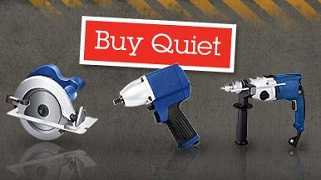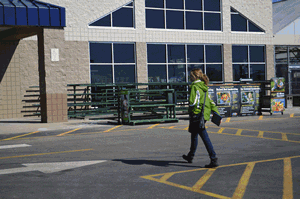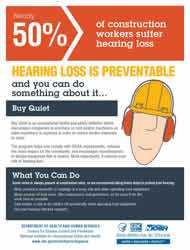BUY QUIET

Components of a Buy Quiet Program
NIOSH encourages companies to start Buy Quiet programs. A model program could include:
An inventory of a company's existing machinery and equipment with respective noise levels. The company’s purchaser can use the inventory to compare the noise emission levels of differing models of replacement equipment prior to their purchase. The inventory is then updated as equipment inventories are expanded or newer quieter equipment is purchased to replace retiring worn out louder equipment. The inventory can also be used for facilitating, documenting, tracking, and promoting a company's Buy Quiet purchase.

A Buy Quiet company policy or procedure. Company policy can be an easy and effective way for employers to show commitment to using the best available technology to protect the hearing and well-being of their employees. Levels of commitment may include:
- Buy Quiet Beginners: Commit to purchase replacement machinery that produces less noise than the original machinery.
- Mid-Range Level: Commit to purchase the most cost-beneficial piece of machinery available that produces less noise than the original machinery.
- Highest Level: Commit to purchase the quietest piece of machinery available regardless of price.

Educational materials and promotional tools designed to help inform their employees, management, customers, and the community about the importance and benefits of Buy Quiet. NIOSH developed a series of posters for construction companies to post at their worksites to communicate their organization’s efforts and commitment to reducing noise levels in and around those worksites. View and print the posters here .
Analysis of the Cost-Benefit of Buying Quiet. Calculation methods can be used to determine return on investment and the true cost of purchasing one piece of equipment over another based on multiple factors; the cost of the quieter product, the cost to society, the business, and the individual if a significant hearing loss is incurred. In many cases, the quieter piece of equipment is the least costly alternative when all life cycle costs of the machinery, possible worker’s compensation claims, costs associated with a company’s hearing conservation program, costs of healthcare (such as hearings aids), and lost productivity are considered. Conservative estimates provide $100 per dBA of savings when purchasing the quieter product.1 This savings is applicable across a wide variety of machinery and equipment.
References
1 Nelson D [2011]. Adaptation of NASA buy-quiet process roadmap for construction firms. Cincinnati, OH: U.S. Department of Health and Human Services, Public Health Service, Centers for Disease Control and Prevention, National Institute for Occupational Safety and Health, 212-2011-M-38379, 2011 Apr; :1-21.
- Page last reviewed: March 27, 2014
- Page last updated: July 10, 2014
- Content source:
- National Institute for Occupational Safety and Health Division of Applied Research and Technology (DART)



 ShareCompartir
ShareCompartir